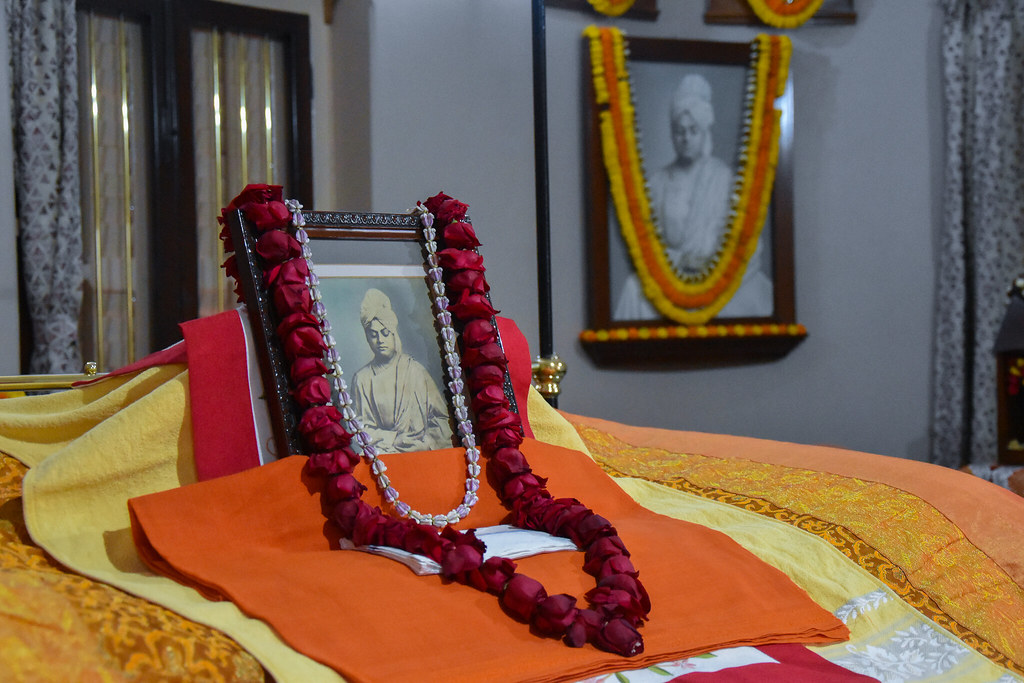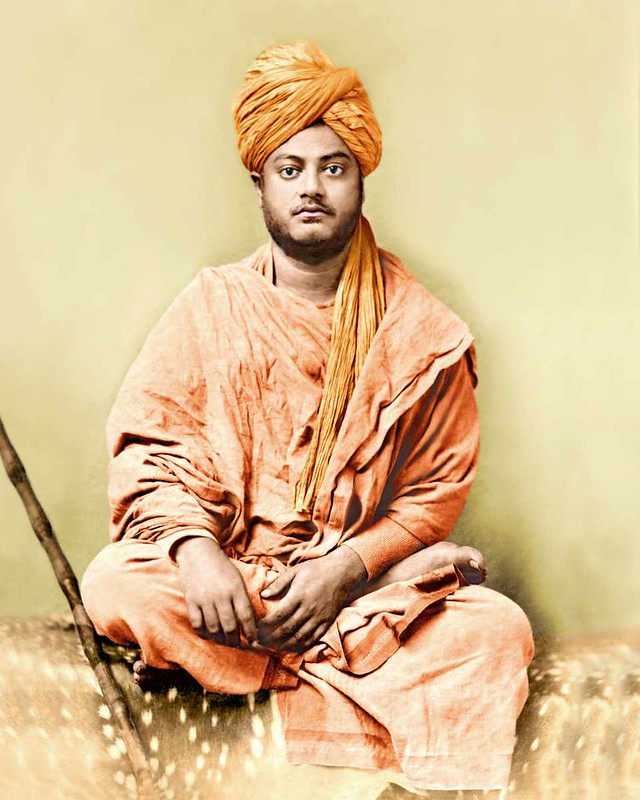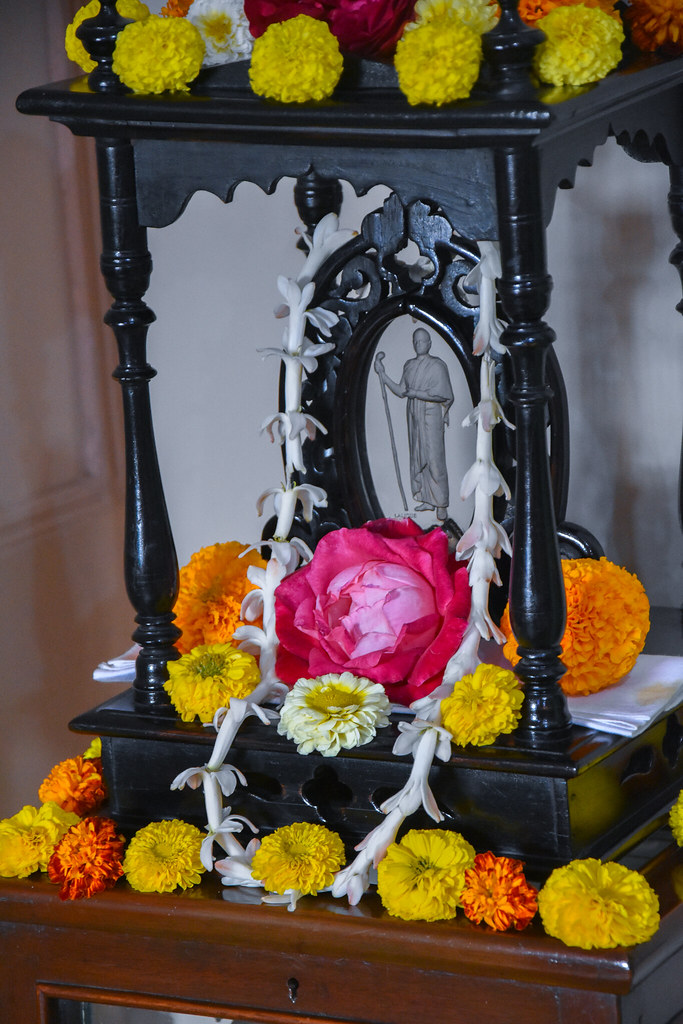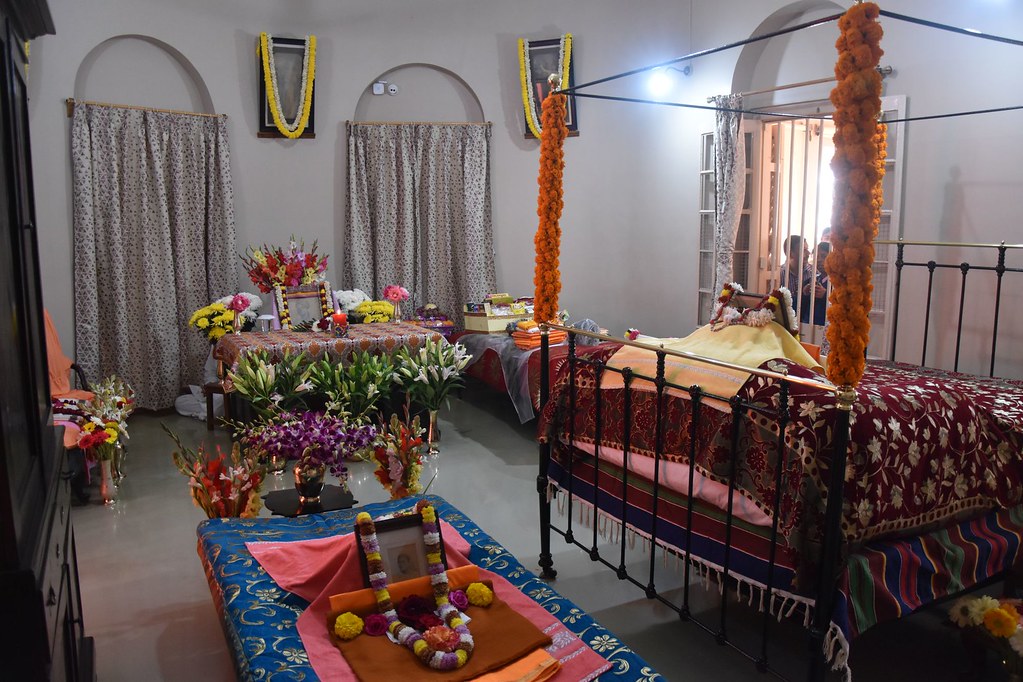Here lived the great sage who Sri Ramakrishna said was a ‘Dhyana Siddha (perfect in meditation) even from the very birth’. During Swamiji’s time the room must have been less cluttered than it appears today with many pieces of furniture and miscellaneous things. Swamiji was a man without frontiers and would have liked to live and move like free air. We can imagine him in a spacious room with bare minimum furniture, sitting quietly or meditating, or being absorbed in the scenic beauty of the Ganga. The fact is that many things in this room were later additions. As days went by, things used by Swamiji at different places were received at Belur Math and began to accumulate in his room for want of a better place.

Let us now look into the room.
Things like Swamiji’s clothes and footwear are preserved here. We also see his canes, his turban in two glass cases, a pakhawaj and a tanpura, the musical instruments he used. The large cot that we see here was gifted to him by his western disciples. However, he did not use it much. He preferred the canvas cot lying adjacent to it, or he lay down on a mat spread on the floor.
On the eastern side of the room are a table and a chair. On the table there is a picture of Sri Ramakrishna on a wooden altar. Beside the photograph there is an oval crystal image of Swamiji as a wandering monk. In this crystal Swamiji is conceived of as the great God Shiva; hence, the Bull, the vehicle of Shiva, in front of him. Miss Josephine McLeod, an American associate of Swamiji, got it made most likely in 1917. In fact, she got a number of them made and happily distributed them to people as a kind of ‘visiting card’, as she said. Why crystal? ‘Nothing but crystal can represent Swamiji’ was her insightful answer.
Swamiji loved his room and was always glad to be back in it after his travels, and even after a short visit to Kolkata. In this room he wrote, gave instructions to his brother-monks and disciples, received his friends, had his meal, slept, and communed with God. And in this very room he gave up his body in final meditation.
Here are excerpts from some of the letters he wrote from this room:
‘Here I am writing in my room on the Ganga, in the Math. It is so quiet and still! The broad river is dancing in the bright sunshine, only now and then an occasional cargo boat breaking the silence with the splashing of the oars. It is the cold season here, but the middle of the day is warm and bright every day. … Everything is green and gold, and the grass is like velvet; yet the air is cold and crisp and delightful.’
‘The moon is not up yet, but there is a sunless glow upon the river. Our mighty Ganges (She is indeed mighty now, during the rains) is splashing against the walls of the house. Numerous tiny boats are flitting up and down in the dark; they have come to fish for our shads, which come up the river this season. … How I wish you were here to taste our shads —one of the most delicate fish in the world. It is raining outside—pouring. But the moment this downpour ceases, I rain through every pore—it is so hot yet. …
‘I would not take any supper tonight, as I ate rather heartily of the aforesaid shad! Then I have to think, think, think on my theme; and some subjects I think best in bed because the whole is made clear to me in dream. Therefore, I am going to bed, and Gute Nacht (good night), bon soir (good evening), etc., etc. No, no, it is now about 10 a.m. in Detroit. Therefore, a very happy day to you. May all good realities reach you today while I am expecting dreams.
Ever yours with love and blessings,
Vivekananda.
Swamiji is still here!
During the dedication of Swamiji’s temple in January 1924, Swami Shivananda said: ‘Swamiji lives in this Belur Math even now. How many days I have seen him in his room immersed in deep meditation! Sometimes I saw him pacing in the room.’ It is worth recalling a few experiences of some disciples of Sri Ramakrishna:
Years after the demise of Swamiji, Swami Vijnanananda was asked: ‘Do you see Swamiji even now?’ Swami Vijnanananda’s reply was: ‘Won’t I see him when he is here?’ He clarified his statement on another occasion: ‘Swamiji is still here! When I pass by his room, I tiptoe lest he should be disturbed. I don’t generally look into his room lest his eyes should catch mine. He takes his walk along this balcony, moves about on the terrace, sings in his room, and does many other things.’
Swami Akhandananda’s pre-monastic name was Gangadhar, and Swamiji used to affectionately call him as ‘Ganga’ or ‘Ganges’. It was the time of Durga Puja in 1933. During those days Swami Akhandananda was seen sitting near Swamiji’s room and chanting Durga’s Name aloud in the early morning. When asked for the reason, his simple answer was, ‘I am chanting for Swamiji to hear’. And on one night he had a vivid dream: Swamiji appeared before him and asked, ‘Ganga, see, my clothes smell of moth balls. Will you not give me a new set on this auspicious day?’ Swami Akhandananda woke up with a start and went straight to the pujari swami’s room, woke him up, and told him, ‘Take a piece of new cloth and follow me.’ The young swami could not understand what the matter was. But he obeyed Swami Akhandananda implicitly. Then they went to Swamiji’s room. After burning incense there, Swami Akhandananda sprinkled perfume over the new cloth and offered it to Swamiji. Then he asked the young swami to perform mangalarati! ‘But, Maharaj,’ the perplexed pujari swami murmured, ‘it is just 2:30 a.m.’ As if he was in a world of bliss, Swami Akhandananda insisted, ‘Today consider 2:30 a.m. as 4:00 a.m. and do the arati.’ The pujari obeyed him.
For want of a resting place, two young swamis once slept in the narrow passage in front of Swamiji’s room. Seeing this, Swami Shivananda asked them to get up and sleep elsewhere. He told them, ‘My boys, Swamiji walks here; it will be inconvenient for him if you people rest here. He very much lives here. Don’t obstruct his movements.’
Another day Swami Shivananda was seen in front of Swamiji’s room looking intently inside the room and repeatedly saying, ‘Good morning, Swamiji’. Later he told others, ‘Today is a blessed day. I got the vision of Swamiji. Finishing his morning walk he was entering the room; it was just then I saw him. He was overwhelmed in bliss.’ That whole day Swami Shivananda was in Swamiji-consciousness and reminisced about Swamiji.
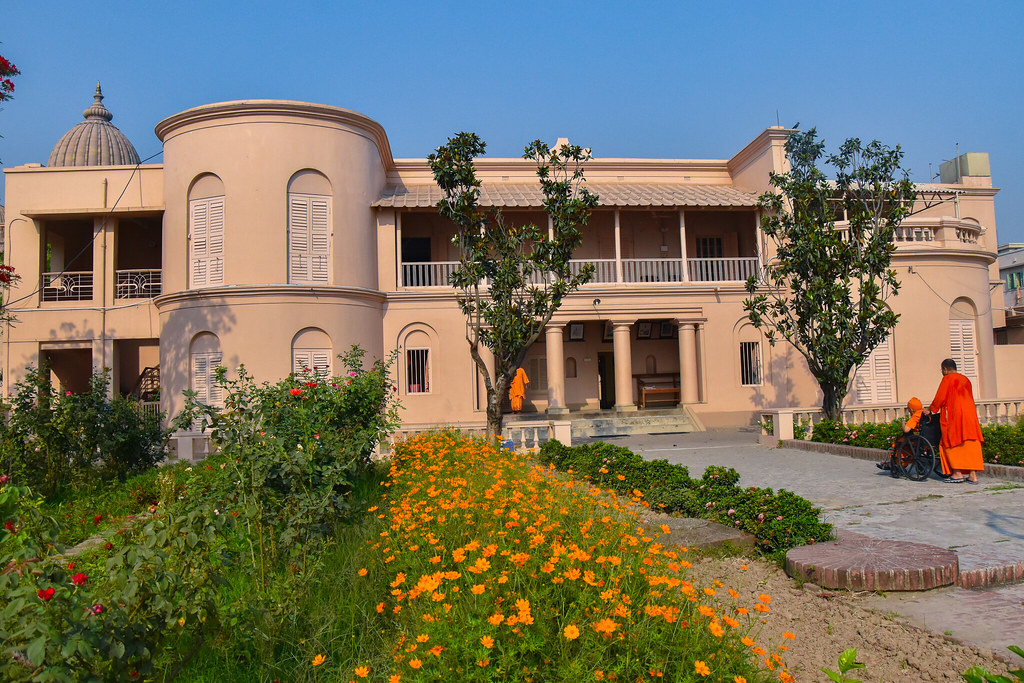
We offer our pranams to Swamiji and slowly descend the stairs immersed in his thoughts, and proceed on the pathway running parallel to the Ganga towards the other temples. We cannot but think, ‘Ah! How many times would the holy feet of Swamiji have trodden this path! Almost all the apostles of Sri Ramakrishna and the later monks of the Order and innumerable devotees from all over the world have walked here!’
There is a small flower garden to our right between the Math courtyard and the lawn lying towards the eastern side of the Sri Ramakrishna temple. Here under a Vilva tree Swamiji worshipped Sri Ramakrishna on the day (Friday, 9 December 1898) when the Math was shifted from Nilambar House to this place.
As we proceed further towards the temples, we notice Nagalinga and Bangshee-bat—the two big trees on the left of the pathway. They were planted under the supervision of Swami Brahmananda.

